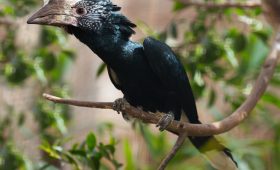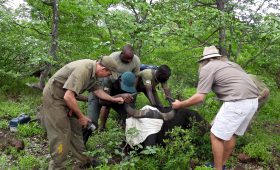By Tatenda Mujeyi
The 31st post for 2021 by the African High-Level Panel on Innovation and Emerging Technologies (APET) called for while commending existent efforts to utilize technology as a way to curb wildlife crimes.
Wildlife crimes have had an adverse toll on the management of wildlife and vegetation as evidenced by the growing markets and the increased extinction and reduced varieties thereof.
In light of this, “the African Union High-Level Panel on Innovation and Emerging Technologies (APET) is encouraging African countries to increase efforts towards adopting technologies so to combat these crimes.” According to the 31st edition of a series of blogs being published by the African Union Development Agency, AUDA-NEPAD Secretariat on behalf of (APET) and the Calestous Juma Executive Dialogues (CJED).
The UN collaborated blog noted the negative effects of the continually growing wildlife crime market which is noted as being estimated to be valued at US$40 billion globally.

“Wildlife trade is predominantly conducted on illegal markets that have unfortunately expanded with the augmentation of e-commerce platforms promoted by dark and social media websites. In 2016, the United Nations (UN) estimated that illegal wildlife poaching was valued at US$23 billion annually. Apart from poaching, Africa loses approximately US$ 17 billion annually towards illegal logging activities as the demand for timber is at an all-time high.” The panel highlighted.
While a large assortment of species including green turtles, wild dogs elephants, rhinos were tagged as highly porched, the African pangolin was the most trafficked with game rangers at risk in their execution of duties.

“Regrettably, the African pangolin is one of the most trafficked animals in Africa. Black and white rhinos are also being mercilessly poached in Africa for their horns for traditional medicine applications. Wild gorillas, chimpanzees, elephants, green turtles, and wild dogs are amongst the highly poached animals. In addition, it has been reported that approximately 600 game rangers have died due to poaching occurrences between 2009 and 2016.”The UN Panel said.
The collaborative research note commended the existent commitment by African governments to address the wildlife crimes as realized through policy, incarceration of offenders, increased fines, and human resource among other issues.
“In addition, the frameworks were also implemented to improve governance, integrity and enhance regional, inter-regional cooperation. As such, African governments have increased game rangers and poaching penalties. Furthermore, there have been increased jail sentencing on poachers and illegal loggers to deter would-be offenders from committing wildlife crimes.”
The technologies which the blog recommended included drones which as used in Botswana had managed to maintain Botswana’s reputation of having the largest elephant population.
“APET is also urging African countries to adopt artificial drone technologies to protect wildlife efficiently. For example, Botswana, with the largest elephants population, has utilized drones to monitor and sufficiently protect the elephants. Fundamentally, drones are used for survey and management purposes.”
Partnerships and satellite trekking were also realized as appositive technology adoption in controlling human and wildlife conflict as it was utilized in Uganda to protect communities from Gorillas.
East Africa on Technology and Wildlife Conservation
“The Ugandan government monitors gorillas in partnership with Inmarsat, a British satellite telecommunications company, through mobile technology solutions. This mobile technology captures and streamlines data generated from human-wildlife conflict incidents. Thus, the mobile technology system provides real-time data that enables rangers to notify the community in real-time when the gorillas are within the community’s vicinity.”
Zimbabwe on Technology and Wildlife Conservation
Zimbabwe has been adopting similar trends despite the technical challenges in realizing the full adoption as a wildlife conservation tool.
“In addition, most protected areas are now using drones for quick area scanning to detect any illegal activity. There has been a shift from the use of analog radio communication systems to digital systems where field data is reported to the operations office in real-time.” .” AWF Technical Advisor, Mana Pools, Simon Muchatibaya said in an interview.
Advances in technology have been hampered by the resistance from some operatives who think that these gadgets work against them, eg by monitoring rangers and reporting them to supervisors.”
Through training and information sharing we are realizing a great charge in the attitude of operatives towards technology as many of them are regarding it as an important tool that actually makes their work very easy and effective.
In a bid to monitor trafficking online, “the Worldwide Fund for Nature (WWF) and the International Fund for Animal Welfare (IFAW) launched the Coalition to End Wildlife Trafficking Online (CEWTO) campaign to discourage online illicit trading and poaching. Through this initiative, 34 e-commerce, search, and social media technology companies are joining forces with wildlife organizations to tackle the illegal wildlife trade.”
The blog noted the ever-complicated encrypted nature of online transactions as curtailing the potential verification of wildlife crime funds and black sites despite their commitment.
Regrettably, trans-continental trade has expanded lately and thus contributing to the increased demand for Africa’s wildlife by other continents. As such, this has complicated enforcement agencies’ abilities to detect illicit trading. This is especially complicated by the encrypted nature of the online transactions undertaken during illicit trading across e-commerce platforms.
Zimbabwe has done quite well in adopting technology for wildlife mitigation be it in human-wildlife conflicts or wildlife poaching.
“We are using GPS-enabled collars to monitor iconic species such as elephants, lions as well as camera traps in places that poachers are known to frequent. These traps are linked to monitors in operations offices and once there is an intruder the camera triggers and sends a message to the office in real-time for immediate action.” AWF Technical Advisor, Mana Pools, Simon Muchatibaya said in an interview.
While challenges have been existent in meeting the technological challenges of having enough equipment development partners have sought to ensure that technology is spread throughout the country.
“AWF is working to resolve this and is currently leading efforts to improve tech for conservation in the Zambezi valley by:
1. Installing digital radio systems in Chewore and Mana pools.
2. Supporting SMART programs in Zambezi valley and recently acquired a Toyota land cruiser vehicle for SMART data collection.
3. AWF acquired a state-of-the-art anti-poaching boat that uses a radar system to capture data during river operations (this is the only boat of such type in anti-poaching county-wide),
4. AWF is providing camera traps and thermal imaging scopes for use during anti-poaching operations.” Muchatibaya also said.
APET emphasized that “the utilization of modern technologies can potentially and adequately enable Africa’s ability to preserve its precious animals and plants in a collaborative and timely manner. When it comes to wildlife, Africa can either come together and protect wildlife or do nothing and watch wildlife disappear forever.”



